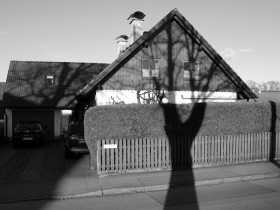Erik van der Weijde
24 Oct - 10 Dec 2008
ERIK VAN DER WEIJDE
Foam 3_h: Erik van der Weijde - Siedlung
24 October - 10 December 2008
As part of the Foam_3h exhibition series Foam presents Siedlung by photographer Erik van der Weijde. Siedlung, German for ‘settlement’, features 220 black-and-white photos of detached houses in southern Germany. In Nazi Germany in the 1930s, the National Socialist Party (NSDAP) set up a huge construction programme to provide Seidlung houses for workers who agreed to become party members.
This Siedlung policy proved a highly successful propaganda tool and helped win the loyalty of the working class to the Nazi state as well as providing the Lebensraum, or living space that played such a key role in Nazi thinking. The regional style in which the houses were built was designed to give residents a feeling of Heimat, or homeliness, while their uniform character was intended to nurture the sense of unity of the German people.
Van der Weijde is fascinated by the ambiguity of his subject: thus while the Third Reich stood for destruction it also promoted construction. A compulsory garden, for example, enveloped each house in an idyllic setting, yet was also designed as a source of homegrown food in wartime. In a sense, these Siedlungen represent the positive remnants of the Third Reich, although they are forever associated with their original residents: Nazi party members with a certificate from their doctor to say they were fertile and racially pure.
Many of these low-cost working-class houses are today prized and sought-after properties.
In his earlier work, Van der Weijde also investigated ambiguous subjects, such as buildings or places that combine collective and personal stories. Like the ‘Ice-Skating Lanes’ series in which Van der Weijde photographed skating rinks that the Belgian psychopath Marc Dutroux visited before kidnapping his young female victims.
Erik van der Weijde (b. 1977, Dordrecht) studied Art History at the University of Amsterdam (UvA) before switching to Rietveld Academy in 2003 where he graduated. Van der Weijde hopes to complete his current studies at Rijksacademie at the end of this year. Van der Weijde has published various art books, including 'Third Reich Patinoire, Caravans, Church Houses, Niemeyer' (2007), 'foto.zine nr.1 #1 t/m #8’(2005) and ‘Praia' (2004). Previous exhibitions include shows at Shashin Art Bookshop, Amsterdam (2007), Fotofrьhling, Kassel, Het Wilde Weten, Rotterdam, Nederlands Fotomuseum, Rotterdam and Dorottya Gallery, Budapest, Hungary (2008).
Siedlung is made possible with support from SBK Amsterdam and Van Bijlevelt Stichting.
Siedlung, by Erik van der Weijde can be seen from 24 October to 10 December 2008 at Foam_Fotografiemuseum Amsterdam. Open daily 10.00-18.00, Thurs/Fri 10.00-21.00. Tickets: Ђ 7.00
Note to editors: For information and visual material please contact Merel Kappelhoff (communications), e-mail merel[AT]foam.nl or phone +31 (0)20 5516500.
Foam 3_h: Erik van der Weijde - Siedlung
24 October - 10 December 2008
As part of the Foam_3h exhibition series Foam presents Siedlung by photographer Erik van der Weijde. Siedlung, German for ‘settlement’, features 220 black-and-white photos of detached houses in southern Germany. In Nazi Germany in the 1930s, the National Socialist Party (NSDAP) set up a huge construction programme to provide Seidlung houses for workers who agreed to become party members.
This Siedlung policy proved a highly successful propaganda tool and helped win the loyalty of the working class to the Nazi state as well as providing the Lebensraum, or living space that played such a key role in Nazi thinking. The regional style in which the houses were built was designed to give residents a feeling of Heimat, or homeliness, while their uniform character was intended to nurture the sense of unity of the German people.
Van der Weijde is fascinated by the ambiguity of his subject: thus while the Third Reich stood for destruction it also promoted construction. A compulsory garden, for example, enveloped each house in an idyllic setting, yet was also designed as a source of homegrown food in wartime. In a sense, these Siedlungen represent the positive remnants of the Third Reich, although they are forever associated with their original residents: Nazi party members with a certificate from their doctor to say they were fertile and racially pure.
Many of these low-cost working-class houses are today prized and sought-after properties.
In his earlier work, Van der Weijde also investigated ambiguous subjects, such as buildings or places that combine collective and personal stories. Like the ‘Ice-Skating Lanes’ series in which Van der Weijde photographed skating rinks that the Belgian psychopath Marc Dutroux visited before kidnapping his young female victims.
Erik van der Weijde (b. 1977, Dordrecht) studied Art History at the University of Amsterdam (UvA) before switching to Rietveld Academy in 2003 where he graduated. Van der Weijde hopes to complete his current studies at Rijksacademie at the end of this year. Van der Weijde has published various art books, including 'Third Reich Patinoire, Caravans, Church Houses, Niemeyer' (2007), 'foto.zine nr.1 #1 t/m #8’(2005) and ‘Praia' (2004). Previous exhibitions include shows at Shashin Art Bookshop, Amsterdam (2007), Fotofrьhling, Kassel, Het Wilde Weten, Rotterdam, Nederlands Fotomuseum, Rotterdam and Dorottya Gallery, Budapest, Hungary (2008).
Siedlung is made possible with support from SBK Amsterdam and Van Bijlevelt Stichting.
Siedlung, by Erik van der Weijde can be seen from 24 October to 10 December 2008 at Foam_Fotografiemuseum Amsterdam. Open daily 10.00-18.00, Thurs/Fri 10.00-21.00. Tickets: Ђ 7.00
Note to editors: For information and visual material please contact Merel Kappelhoff (communications), e-mail merel[AT]foam.nl or phone +31 (0)20 5516500.

